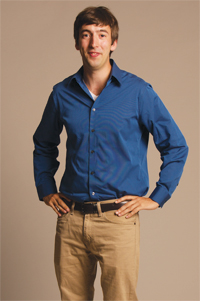Henri Dwyer
MS Candidate Earth and Environmental Engineering

For many, garbage is just garbage; for Henri Dwyer, it is a chance to make a difference in the environment and the world.
As an undergraduate, Henri Dwyer studied quantum physics but now, as he works toward a master’s in Earth resource engineering, he has been all consumed with something else entirely—trash. Turning waste to energy, to be exact.
“My ultimate goal is to start my own company, leveraging my technical and scientific skills in an innovative way to tackle our global energy challenges so we all become more efficient consumers of energy,” Dwyer says. “I believe waste to energy is a great pathway toward my goal.”
Dwyer, expected to graduate in December, spent one undergraduate semester running tests on river power, physically installing turbines near bridge pillars to see how they could increase power output. That experience instantly hooked him on waste-to-energy (WTE) research. A scholar in the NSF S-STEM Sustainable Engineering GradUatE (SEGUE) Scholars Program at Columbia, Dwyer is part of a small cohort of engineers focused on studying societal and environmental challenges, emphasis on water, energy, and infrastructure.
This opportunity was perfect for Dwyer, a dual French and American citizen who attended the famed Ecole Polytechnique in Palaiseau, France. He intends to complete his last year of Ecole Polytechnique’s engineering program in conjunction with the completion of his master’s program at Columbia Engineering.
Also a junior researcher on Columbia’s Waste-to-Energy Research and Technology (WTERT) Council, Dwyer studies dioxins to see if rumored WTE and incinerator pollution fears are justified, concerns about the open-air combustion process that can produce dangerous pollutants. His analysis includes taking raw data from more than 90 percent of U.S. WTE plants to obtain dioxin emissions. He also works with Environmental Protection Agency (EPA) data calculating nationwide dioxin emissions. His goal: learning how the main dioxin sources’ emissions have evolved over the years and WTE’s role in that.
“Generally, waste to energy deals with converting municipal solid waste or household trash into electricity and heat,” Dwyer explains. “In the U.S., with little demand for hot steam, the focus is usually on electricity.”
According to a 2012 report by the EPA, the average American generates more than four pounds of trash a day, resulting in 251 million tons of trash for the year, most of which ends up in landfills.
Landfills’ disadvantages, Dwyer notes, are residual air and water pollution, while leftover ash from the WTE process has a much lower volume than the original trash and can be cleaned and reused in cement or road pavement, for example. But the WTE method is not without controversy.
“There are two main blocks to wider adoption: initial costs and public perception,” Dwyer says. “A WTE plant can cost several hundred million dollars to build, so it can be difficult for municipalities or companies to raise enough capital. The second block stems from the history of waste to energy.”
Dwyer commented that over the last 20 years stricter regulations and better technology have turned the WTE industry into a much cleaner one, but its reputation lingers.
Roadblocks and lingering problems aside, Dwyer is up to these challenges. His preliminary results focusing on WTE and landfill nationwide dioxin emissions, along with health risks analysis, were recently presented at the 2014 North American Waste-to-Energy Conference. For many, garbage is just garbage; for Dwyer, it is a chance to make a difference in the environment and the world. So Dwyer plans to publish an article and his thesis using scientific sources proving WTE’s claims of safety.
“Hopefully, my results will help convince opponents that their fears of dioxin air pollution are no longer justified,” he says. “I’m really excited about contributing to bettering our energy use and production.”
